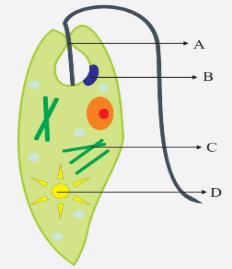
Study the given figure showing the structure of Euglena and select the option that correctly identifies A, B, C, and D.

(a) A - Cytostome, B- Photoreceptor, C - Paramylum bodies, D - Myonemes.
(b) A- Contractile vacuole, B - Photoreceptor, C - Paramylum bodies, D - Chloroplast.
(c) A - Cytostome, B - Stigma, C - Paramylum bodies, D - Chloroplast.
(d) A - Cytostome, B - Stigma, C - Myonemes, D - Chloroplast.

Answer
521.4k+ views
Hint: It absorbs food through the mouth cell. It also has an eyespot that helps in the detection of light. Their body consists of a special carbohydrate that is stored in the cytoplasm along with chlorophyll in plastid from photosynthesis.
Complete answer:
Euglena is a unicellular organism that consists of flagella, this flagellum helps in their movement and locomotion. The whole body of Euglena is covered by a plasma membrane and their coverage is also known as a pellicle. The flagella consist of photoreceptors cells that help in their movement depending upon the availability of light. The stigma is an outer eyespot that helps in the detection of light as it is composed of various photoreceptors. The light then helps in the movement of the body and leads the body towards the light. The cytostome is the cell mouth that helps in the ingestion of food and results in the process of phagocytosis. In this process, feeding takes place by the absorption of food particles. When the food is absorbed, it then passes into the cytostome and then goes to a vacuole where it is sealed in the form of small grooves.
The carbohydrate called paramylum bodies are stored in the cytoplasm of their cells. They are colorless and are similar to starch in properties. They are various in number and vary from species to species.
It also consists of plastids that have chlorophyll in them thus leads to photosynthesis. The chlorophyll is found in the chloroplast which becomes active when light is absorbed by them. The chloroplasts found to be of various shapes and sizes that include rod-shaped or discoidal.
So, the correct answer is ‘A - Cytostome, B - Stigma, C - Paramylum bodies, D - Chloroplast’.
Note:
Myoneme is a structure that is contractile in nature and is made up of protein filaments and may get shorter in the presence of calcium. Photoreceptors are the cells that respond to light and help in the absorption and detection of light. Contractile vacuoles are the organs in the cells that help in maintaining the quantity of water and regulate the osmotic balance in the cell.
Complete answer:
Euglena is a unicellular organism that consists of flagella, this flagellum helps in their movement and locomotion. The whole body of Euglena is covered by a plasma membrane and their coverage is also known as a pellicle. The flagella consist of photoreceptors cells that help in their movement depending upon the availability of light. The stigma is an outer eyespot that helps in the detection of light as it is composed of various photoreceptors. The light then helps in the movement of the body and leads the body towards the light. The cytostome is the cell mouth that helps in the ingestion of food and results in the process of phagocytosis. In this process, feeding takes place by the absorption of food particles. When the food is absorbed, it then passes into the cytostome and then goes to a vacuole where it is sealed in the form of small grooves.
The carbohydrate called paramylum bodies are stored in the cytoplasm of their cells. They are colorless and are similar to starch in properties. They are various in number and vary from species to species.
It also consists of plastids that have chlorophyll in them thus leads to photosynthesis. The chlorophyll is found in the chloroplast which becomes active when light is absorbed by them. The chloroplasts found to be of various shapes and sizes that include rod-shaped or discoidal.
So, the correct answer is ‘A - Cytostome, B - Stigma, C - Paramylum bodies, D - Chloroplast’.
Note:
Myoneme is a structure that is contractile in nature and is made up of protein filaments and may get shorter in the presence of calcium. Photoreceptors are the cells that respond to light and help in the absorption and detection of light. Contractile vacuoles are the organs in the cells that help in maintaining the quantity of water and regulate the osmotic balance in the cell.
Recently Updated Pages
Master Class 12 Business Studies: Engaging Questions & Answers for Success

Master Class 12 Economics: Engaging Questions & Answers for Success

Master Class 12 English: Engaging Questions & Answers for Success

Master Class 12 Maths: Engaging Questions & Answers for Success

Master Class 12 Social Science: Engaging Questions & Answers for Success

Master Class 12 Chemistry: Engaging Questions & Answers for Success

Trending doubts
What is meant by exothermic and endothermic reactions class 11 chemistry CBSE

Which animal has three hearts class 11 biology CBSE

10 examples of friction in our daily life

One Metric ton is equal to kg A 10000 B 1000 C 100 class 11 physics CBSE

1 Quintal is equal to a 110 kg b 10 kg c 100kg d 1000 class 11 physics CBSE

Difference Between Prokaryotic Cells and Eukaryotic Cells




